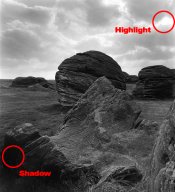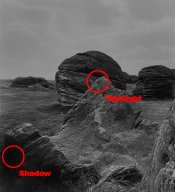jstraw
Member
I'm sure someone has described what I discovered recently, before. While it was an epiphany for me, I'm sure it's familiar to many of you. On the chance that it might be useful for others at a similar level of experience with split printing as I, here is an explanation of what I recognized while working on this print.
Typically, I will identify the primary highlight and primary shadow detail areas before begining to print a negative (fig1.jpg).
I do my soft test strip for the highlight using my test strip easel, determine a base soft exposure, replace the easel with my standard one, expose a sheet of paper to the soft exposure and then change to the hard filter and do an incremental, hard test strip. There I determing the hard exposure. Then I make a split grade print at these base exposures and from that, make decisions about additional burning or dodging.
When I did this with this negative, the highlight was right, the shadow was right and the entire non-sky area was MUD.
What I ended up doing was subtractive, I shortened the soft exposure to get the highlights I wanted in the rocks and then burned the sky back up to the original soft exposure for the original highlight. This worked but something occured to me...something I plan to try with the next negative I'm printing with similar attributes. What occured to me was that the two, clearly distinct print areas could be dealt with as virtually separate prints.
If I'd identified the primary shadow and the primary highlight in the rocks for the lower "print," (fig2.jpg) then identified that highlight exposure from the soft exposure test strip, I'd have determined a soft exposure for that area directly. I can find the desired base, soft exposure for the primary highlight for each of the two "prints" and extrapolate the burn time from the differential between the two strips (fig3.jpg).
Chancer are good that I wouldn't need a different hard exposure for the area that includes the second, burned highlight. But the same thought process could be applied if necessary.
Thoughts?
Typically, I will identify the primary highlight and primary shadow detail areas before begining to print a negative (fig1.jpg).
I do my soft test strip for the highlight using my test strip easel, determine a base soft exposure, replace the easel with my standard one, expose a sheet of paper to the soft exposure and then change to the hard filter and do an incremental, hard test strip. There I determing the hard exposure. Then I make a split grade print at these base exposures and from that, make decisions about additional burning or dodging.
When I did this with this negative, the highlight was right, the shadow was right and the entire non-sky area was MUD.
What I ended up doing was subtractive, I shortened the soft exposure to get the highlights I wanted in the rocks and then burned the sky back up to the original soft exposure for the original highlight. This worked but something occured to me...something I plan to try with the next negative I'm printing with similar attributes. What occured to me was that the two, clearly distinct print areas could be dealt with as virtually separate prints.
If I'd identified the primary shadow and the primary highlight in the rocks for the lower "print," (fig2.jpg) then identified that highlight exposure from the soft exposure test strip, I'd have determined a soft exposure for that area directly. I can find the desired base, soft exposure for the primary highlight for each of the two "prints" and extrapolate the burn time from the differential between the two strips (fig3.jpg).
Chancer are good that I wouldn't need a different hard exposure for the area that includes the second, burned highlight. But the same thought process could be applied if necessary.
Thoughts?















